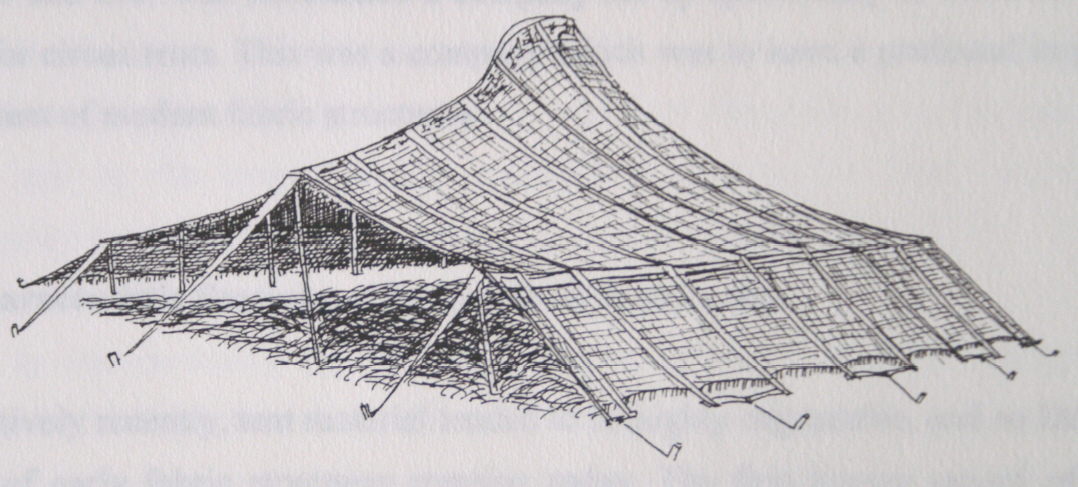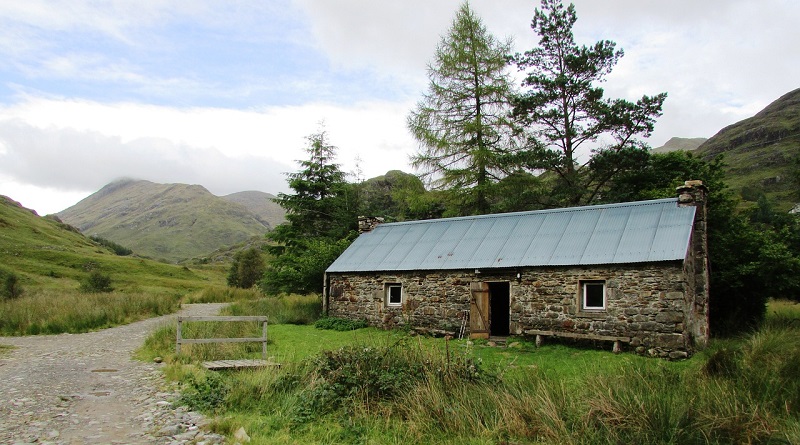Shelter

|
| Black tent |
Contents |
[edit] History
Very broadly, shelters provide physical protection from something that is potentially harmful.
Remains have been found of simple structures constructed from animal skins draped between sticks dating back over 40,000 years, and it is likely these were the first type of shelter constructed by humans.
Simple tents suited a nomadic lifestyle. Lightweight and easy to carry, they could be moved from place to place in harsh environments where it was necessary to keep on the move to stay alive. Where resources were more plentiful, it was possible to settle down and build permanent shelters in the form of huts. In intermediate environments, a whole range of composite structures developed, part tent, part hut, most notably the Yurt, a demountable hut, still in use in places such as Mongolia today.
This combination of a fundamental requirement for shelter, moderated by practicality and resource availability, still drives the design of our buildings today, and can be seen in as varied typologies as the Troglodytic architecture of sculptured hillside landscapes in Morocco, to the Eskimos’ igloos, to Malaysian tree-dwelling, African courtyard houses, and the English thatched cottage.
[edit] Function
Very broadly shelters might be required to provide:
- Privacy.
- Security.
- Cover from the sun, rain, wind, snow and so on.
- Control of temperature, air movement, humidity, air quality, noise and so on.
- A status symbol.
- A meeting point.
- Permanent or temporary accommodation.
[edit] Other types of shelter

|
| A bothy in the Scottish Highlands. |
- Air-raid shelter: used for protecting civilian and military personal from bomb attacks. They may be improvised from existing structures eg, London Underground tunnels or be specially designed.
- Animal shelter: provides a home (usually temporary) for abandoned or lost animals.
- Bivouac shelter (British: ‘bivvy’ for short): this is usually a temporary shelter of any lightweight construction used by mountain climbers or scouters. They may construct a bivouac shelter from branches and leaves. A bivouac sack often used by mountaineers and army personnel is a small, lightweight, waterproof bivouac shelter that may comprise a simple covering over a sleeping bag and can fit easily into a backpack.
- Blast shelter: provides protection from blasts and explosions from weapons.
- Bothy: a small shelter that has been restored from a ruinous condition to provide basic, temporary accommodation to passers-by, such as hill walkers. Usually unlocked, they are typically made of stone, have a pitched roof and are particularly common in the Scottish Highlands and other upland areas of the UK.
- Bus shelter: provides protection from wind and rain while awaiting the arrival of a bus.
- Canopy: An overhead roof structure that has open sides. Canopies are typically intended to provide shelter from the rain or sun, but may also be used for decorative purposes, or to give emphasis to a route or part of a building.
- Emergency shelter: provides temporary shelter for people when their homes have been partially or permanently affected by various phenomena including floods, earthquake, explosions, avalanches, social unrest, war and so on.
- Fallout shelter: provides protection from radiation such as that which might occur as a result of nuclear explosions or nuclear accidents.
- Homeless shelter: provides a temporary bed and washing facilities to those who might otherwise have to sleep on the streets.
- Refuge: a special cabin used in underground construction into which workers may retreat in the event of an emergency, eg a gas leak or rock fall, where they remain until help arrives. Refuges are usually stocked with oxygen, water and other basic provisions.
- Rock shelters: natural formations in cliffs where softer rock has been eroded over time to form a type of cave that may provide shelter from the elements.
- Ramada: a shelter with roof and no walls that is constructed from branches or bushes for the sole purpose of providing solar protection. Ramadas may be temporary or permanent and are found mainly in the southwestern USA. Modern varieties may also be built with commercially available construction materials.

|
[edit] Related articles on Designing Buildings Wiki
- Adobe.
- Cob building.
- Construction materials.
- Earthen construction.
- Emergency healthcare architecture in Brazil.
- Fabric structures.
- Green building.
- Managing and responding to disaster.
- Practical Building Conservation: Earth, Brick and Terracotta.
- Resilience.
- Roof.
- Sheltered area.
- Smoking shelters.
- Types of building.
Featured articles and news
Key points for construction at a glance with industry reactions.
Functionality, visibility and sustainability
The simpler approach to specification.
Architects, architecture, buildings, and inspiration in film
The close ties between makers and the movies, with our long list of suggested viewing.
SELECT three-point plan for action issued to MSPs
Call for Scottish regulation, green skills and recognition of electrotechnical industry as part of a manifesto for Scottish Parliamentary elections.
UCEM becomes the University of the Built Environment
Major milestone in its 106-year history, follows recent merger with London School of Architecture (LSE).
Professional practical experience for Architects in training
The long process to transform the nature of education and professional practical experience in the Architecture profession following recent reports.
A people-first approach to retrofit
Moving away from the destructive paradigm of fabric-first.
International Electrician Day, 10 June 2025
Celebrating the role of electrical engineers from André-Marie Amperè, today and for the future.
New guide for clients launched at Houses of Parliament
'There has never been a more important time for clients to step up and ...ask the right questions'
The impact of recycled slate tiles
Innovation across the decades.
EPC changes for existing buildings
Changes and their context as the new RdSAP methodology comes into use from 15 June.
Skills England publishes Sector skills needs assessments
Priority areas relating to the built environment highlighted and described in brief.
BSRIA HVAC Market Watch - May 2025 Edition
Heat Pump Market Outlook: Policy, Performance & Refrigerant Trends for 2025–2028.
Committing to EDI in construction with CIOB
Built Environment professional bodies deepen commitment to EDI with two new signatories: CIAT and CICES.
Government Grenfell progress report at a glance
Line by line recomendation overview, with links to more details.
An engaging and lively review of his professional life.
Sustainable heating for listed buildings
A problem that needs to be approached intelligently.
50th Golden anniversary ECA Edmundson apprentice award
Deadline for entries has been extended to Friday 27 June, so don't miss out!
CIAT at the London Festival of Architecture
Designing for Everyone: Breaking Barriers in Inclusive Architecture.
Mixed reactions to apprenticeship and skills reform 2025
A 'welcome shift' for some and a 'backwards step' for others.


























